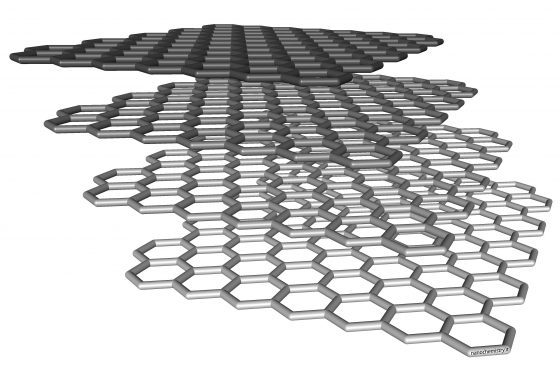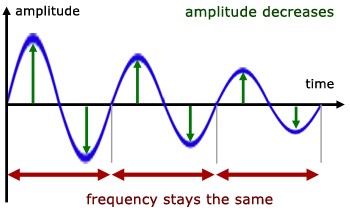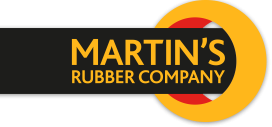Damping characteristics can now be tailored to applications thanks to Martin’s Rubber’s development work with nanomaterials
Posted on 18/01/2018 Category: Technical Features, What's New

Through the use of functionalised nanomaterials, Martin’s Rubber can enable engineers to tailor dynamic characteristics of rubber compounds for optimum performance in any given application.
What is damping?
Damping is the reduction of the amplitude of a wave, created by mechanical force, through the process of turning that wave into thermal energy. In other words, it is the reduction (or in some cases, elimination) of vibration or noise (see. Fig 1).
Why is damping important?
Vibration and noise can have a negative impact on equipment and therefore individuals in an industrial (or domestic) setting; by using damping on loud or vibrating equipment, it can improve the likely lifespan and effectiveness of equipment, reduce dangers caused by noise and movement, and also improve the ergonomics of a person’s working environment.

Fig. 1 amplitude decreases over time as a result of damping, in spite of a continuous frequency.
What characteristics should you look for in a damping material?
The performance of a damping material will depend not only the environment in which it is being used, the forces applied to it and the type of energy that is to be damped, but also the characteristics of the material selected.
Damping solutions used within an engineering setting may require a high damping co-efficient, which means that rather than returning the energy to a system, the unwanted vibration will be ‘absorbed’ by the material and diminish any response. In order to compare the suitability of different materials for use under dynamic loading conditions, a damping coefficient is used to enable engineers to understand this particular property of a material and make a judgement about its suitability for an application.
Energy dissipation can be viewed in terms of both discrete impacts, or continuous vibration; a mismatch in the storage vs loss modulus (elastic vs. viscous response [see Fig. 2]) leads to less vibration being conveyed through the chosen damping material because much of it is converted into other forms of energy, such as heat. Rubber is a visco-elastic material, and when considering the optimum material for damping, the balance of elastic and viscous response is paramount. Tan delta is a ratio of the loss to the storage modulus, and gives an indication on the damping behaviour of the rubber, i.e. the energy dissipated by the material.

Fig. 2 Elastic response vs. viscous response
Why is rubber a good material for damping?
Rubber has a complex molecular structure once vulcanised, and the cross-linking that takes place, usually either through sulphur or carbon, gives the molecular network strength, elasticity and other mechanical properties. The material will also have been compounded with fillers that affect the properties of the final product, particularly in terms of the dynamic response.
Which rubber should I choose?
Natural rubber is the standard ‘go-to’ material for damping in less demanding applications because of its longevity, resilience and resistance to a wide range of temperatures. However, where the product is to be used in a high temperature application or with hydrocarbons, the most likely candidate would be an acrylic elastomer; either polyacrylate (ACM) or ethylene-acrylate (AEM) such as Vamac®. These materials are rated for resistance to hydrocarbons, but their resistance is not as high as that offered by some grades of hydrogenated nitrile (HNBR); AEM can achieve a similar resistance, but a specialist (and therefore costly) grade may be required.
By tailoring the properties of HNBR through the use of novel nanomaterials, we can improve its damping characteristics while maintaining the inherent properties of the base elastomer. The performance of a part in service is a highly complex picture, consisting of resistances to various factors including temperature, chemical and mechanical effects. By limiting the material’s changes in exposure to these factors, we can model and maintain the performance in all scenarios.
How is Martin’s Rubber improving the dynamic properties of elastomers?
Working with Haydale, Martin’s Rubber has developed an enhanced compound; by replacing some of the existing filler system with Haydale’s HDPlas™ carbon nanotubes, we are able to reduce the weight of the final product, increase the elongation to break, tensile modulus, and load deflection characteristics, as well as improving the tear resistance. Specific to damping, tan delta is increased using the replacement filler system.
What does this mean?
This development in using nanomaterials in combination with rubber will allow engineers to choose and tailor a material that can work with oils and in high ozone environments but combine this with excellent damping properties, allowing for a much more versatile option in terms of designing finished parts and selecting the most appropriate material for the application.
The uplift in other physical properties, as a result of the introduction of nanomaterials, means that parts may now be either smaller in size than previously designed for an application, or will be able to dissipate more force, providing potential cost- and weight-savings.
Martin’s Rubber uses the entire range of thermoset elastomers, from natural through to fluorocarbon rubber, to offer their customers the best material for their application. We are also dedicated to developing new technologies, and utilising emerging technologies, to increase the options available, for optimum performance in application.
For further information please see our materials development page, or speak to our technical team on 023 8022 6330 or email: [email protected]
The post Damping characteristics can now be tailored to applications thanks to Martin’s Rubber’s development work with nanomaterials appeared first on Martin’s Rubber Company.


